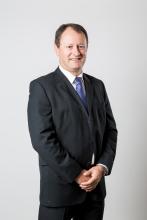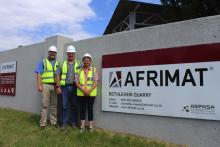
Via the ‘Growth through Diversification’ mantra, Andries van Heerden, CEO of Afrimat, has pushed the company to the top of Africa’s aggregates industry, writes Munesu Shoko.
Nobody has ever been handed greatness on a silver platter. This is true in any aspect of life, including running a business. But optimism is the philosophy at the heart of achievement, and that rings true for Andries van Heerden An eternal optimist and shrewd businessman who has, in the past 10 years, led
Afrimat, a Johannesburg Stock Exchange-listed company, is a leading South African industrial minerals and construction materials supplier, which operates across two main segments, namely mining and aggregates and concrete-based products. In a market estimated at 90-100 million tonnes per year, Afrimat is deemed the biggest supplier of aggregates by volume in South Africa, if not the whole of Africa.
It takes a whole lot of systems and procedures for a business to run successfully, but great leadership is the ultimate key driver. For Afrimat, Van Heerden has been the provider of the much needed guidance, especially for a business that treads in such a cyclical environment.
As we get to grips with Van Heerden’s winning ways, his strategy for further growth and his views on the aggregates industry at large, he explains how the business has navigated the difficult terrain over the years to be what it is today. “The dream that we had at the time when we listed on the JSE a decade ago was to build a diversified business, based on strong values, able to weather storms and always being mindful of doing things right,” he says.
There are a couple of things that Afrimat does differently. The first part is the people aspect, trying to find the best possible talent, identifying a unique contribution each person can make, and marrying that with the company’s goals and requirements. The second part is the strategic aspect. “Today, business is a lot different to what it was yesterday,” he says. “It’s all about strategic management – analysing the current environment, potential opportunities and threats.”
The third aspect is execution. “You can have the best plans in the world, but without execution, nothing materialises,” he says. Speaking of strategy and implementation, one of the key strategies for Afrimat is diversification, which has been succesfully managed over the years. “The crux of our diversification programme started with understanding our core skill. Coming from the quarrying industry, we felt that our core skill was on the operational and marketing side of the business,” says Van Heerden. “Operationally, it is the open-pit hard rock mining that we know best. We can mine any operation of any size, from very small to reasonably large operations, and can do it cost effectively.”
“We also understood the marketing dynamics of aggregates, which is a locally-priced commodity. We then stood back and said, what else can we do with these skills? Firstly, we went on a geographic expansion programme 10 years ago. We wanted to go from a regional player to a national force with a countrywide footprint that allowed us to have a better spread because, by its very nature, quarrying can be highly cyclical,” he says. The geographic spread has since exposed Afrimat to where construction activity is. “We also realised that there were other products that could be classified in the same bracket with what we did. Although they were not necessarily construction materials, they also entailed open-pit mining as well as crushing and screening.”
That’s when the company ventured into metallurgical dolomite and eventually into limestone, metallurgical quartzite and alluvial silica businesses. “Each one of these has the same basic principles as open-pit mining and they are locally-priced commodities. We are now sitting with a wider array of potential markets and we tend to see that even at an industrial level,” says Van Heerden.
The diversification strategy has been buoyed by strategic acquisitions of businesses in dire straits and turning them into forces to reckon with. “It’s always the best time to acquire a business at the bottom of the business cycle,” said Van Heerden. There are ample examples to illustrate this. In March 2013, Afrimat concluded a deal to acquire Infrasors, a producer of minerals for the mining, industrial, metallurgical and construction sectors. The deal saw Afrimat taking over the Lyttelton Centurion Mine, an open-cast dolomite mine in Pretoria; Marble Hall Mine, open-cast limestone mining and beneficiation operation in Limpopo; and the Delf alluvial sand and silica operations at Donkerhoek, near Cullinan.
At the time, Infrasors reported lower earnings as sales of metallurgical minerals were beset by a slowdown in the steel industry, along with the shutdown of furnaces. But, today, these operations are far removed from the businesses they were pre-acquisition. Marble Hall is the jewel in the crown of the former Infrasors portfolio. Lyttelton, despite some challenges due to its exposure to the beleaguered steel industry, has seen fortunes reversed and a return to profitability. “After the closure of Highveld Steel we saw a drastic decrease in volumes and the mine turned into a loss-making operation. We then put in a lot of effort into turning around the operation,” says Van Heerden. “We re-engineered the whole process and refocused the product range and as from June-July 2016, the mine is back at its original profitability levels, but with lower volumes and a different model.”
Elsewhere, in April 2016, Afrimat took control of Cape Lime’s two operations, located at Vredendal and Robertson in the Western Cape province of South Africa. In a deal that became the company’s largest acquisition at the time, the total consideration for 100% shares of Cape Lime was settled by a combination of cash and Afrimat shares to a tune of ZAR276 million. “We are very happy with the quality of the business we bought. It has a unique product, with very high quality limestone and dolomite,” says Van Heerden.
Meanwhile, the company’s acquisition of the quarry and ancillary business of WG Wearne Limited in Bethlehem, Free State Province, was effective from 1 November 2016. “It was an operation that was well-situated for us. We already own some few operations in the area and it was within the natural reach for us. We have support systems close by and we understand the market locally.”
While Afrimat has, over the years, maintained its focus on locally-priced commodities, a potential deal to venture into iron ore recently presented itself. Afrimat has concluded an agreement to purchase 60% of Diro Manganese and Diro Iron Ore, after these companies were placed in formal business rescue. “Given Afrimat’s proven track record of turning struggling businesses around, this is an exciting new challenge for the group. It will supplement our diversification by entering into the iron ore market, exposing us to a commodity that is traded in hard currency,” says Van Heerden. The aggregate sum payable for the deal is ZAR276 million.
“We took a view as Afrimat and realised that strategically one of our weaknesses is that we are earning all our revenue in Rand. We were 100% exposed to South Africa and this posed a bigger risk,” he says. “Secondly, although the iron ore market is a lot slower than it was two years ago, we still believe that, with our low-cost operating model, there will still be a better margin than in aggregates.”
Despite a wide footprint across several commodities, the mining and aggregates segment, which makes up about 90% of the revenue contribution from operations, is still a major component of Afrimat’s business. Van Heerden maintains that aggregates will always be an important part of the company’s business.
Speaking of market conditions, he reasons that despite negative sentiment in the South African construction industry, government spending on road building and maintenance, as well as human settlements, water and sanitation, is at an all-time high. “There was a structural change in the market and for the last two to three years we have seen much stronger focus on smaller to medium construction contractors and we are doing less business with large contractors,” he says. “The projects that are driving aggregates volumes in the markets that we serve are mostly road building, as well as smaller infrastructure projects, mostly service delivery types, such as water and sanitation and low-cost housing.”
Looking ahead, Van Heerden expects the current business climate to roll over into 2017 with Afrimat’s growth driven by the successful execution of its proven strategy, recent acquisitions and a wider product offering to the market. “I cannot foresee a slowdown in 2017. I think we will probably sustain the current volumes, if not slight growth. Government spend on infrastructure, considering the looming election in 2018, will probably create a lot of activity.”








